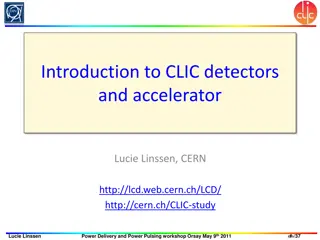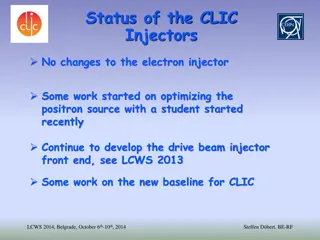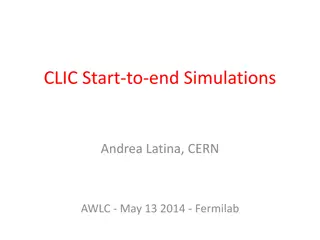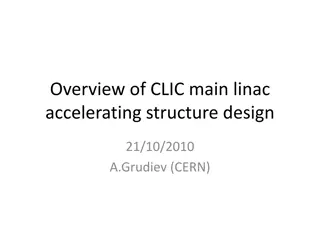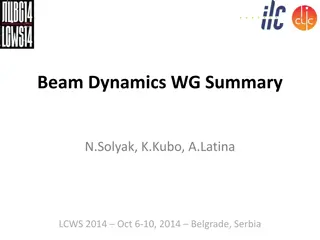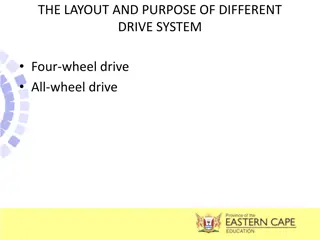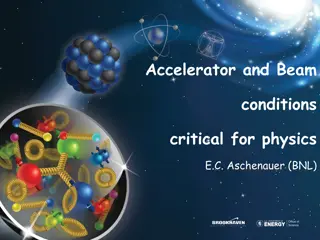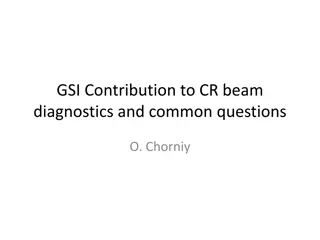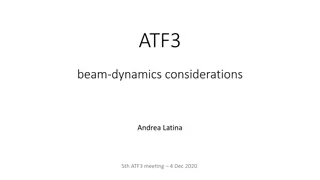Critical Issues in CLIC Drive Beam by Working Group 6 at LCWS11
Issues identified in the CLIC Drive Beam project include RF stability and reliability, beam current stability, RF deflectors in combiner rings, synchrotron radiation power, beam dynamics, operability concerns, machine protection, and beam synchronization challenges. Key areas requiring attention include klystron operability, beam quality, power management, and control algorithms to ensure the successful operation of the drive beam system at CLIC.
Download Presentation

Please find below an Image/Link to download the presentation.
The content on the website is provided AS IS for your information and personal use only. It may not be sold, licensed, or shared on other websites without obtaining consent from the author. Download presentation by click this link. If you encounter any issues during the download, it is possible that the publisher has removed the file from their server.
E N D
Presentation Transcript
CLIC Drive Beam critical issues by WG6 Collected by B. Jeanneret, R. Ruber & P. Skowronski LCWS11, Granada, September 2011
1. RF of the drive beam linac. - Availability (stability, reliability, operability of 1600 klystrons). - Demonstration of high yields (89% modulator, 70% klystron). -Smooth start/stop of 255 MW for network. 2. Drive Beam current stability. - The stability and the flatness of the current of the drive in the decelerator is specified to be of the order of a few per mil at CLIC. CTF3 cannot fulfill these requirements as of today. Some upgrade may be needed to demonstrate this. - The static level of losses at CTF3 is of the order of 5%. This is too high for CLIC (beam quality, see 2a, and radiation issues at CLIC).
3. RF deflectors in Combiner rings. High current and long pulses combined to offset incoming beam makes the use of a single RF structure unworkable because of wake-fields. Several small independent structures, each fed by its own klystron must be considered. Space occupancy, power management and wake-fields require much further work. 4. Synchrotron radiation power in combiner rings. A 50 Hz pulsed structure, averaging to ~ 1kW/m nearby the exit of dipoles impacts on the vacuum chamber. Material choices and geometry of absorbers to avoid mechanical fatigue and pressure bumps still need to be worked-out.
5. Beam dynamics in the Drive Beam Linac and Combiner rings. -Energy spread and energy errors must be specified carefully to grant a good control of isochronicity in combiner rings. - Non-linearities, transverse and longitudinal need more systematic studies, to ensure a good quality of the beam delivered to decelerators. 6. Operability, overall CLIC. - Algorithms for automatic steering (commissioning, setting- up, stability, recovery from failure). - Control and operation (knobs and read-out channels: 520k for two-beam modules, 120k for the rest). Items not yet sufficiently studied. They may contains critical issues
7. Machine protection with a 100A drive beam (70 MW average power per beam). - Drive Beam failures driving Main Beam losses. - Impact of the latter ones. 8. Synchronization of beams in the femto-second range. - Internal between DB trains - DB with MB , in one linac - MB with MB , linac to linac MB with MB , linac to linac Items common with other WG s. Most likely listed elesewhere


